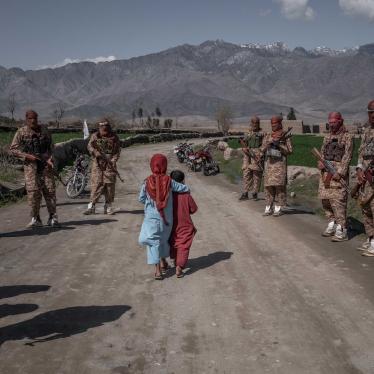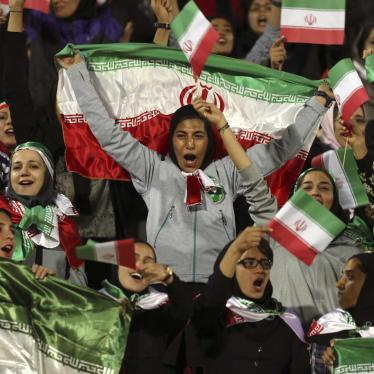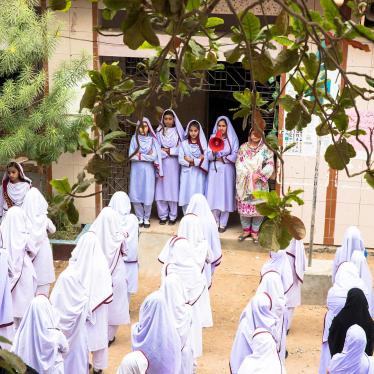(Jerusalem, January 7, 2009) - The United Nations Security Council, meeting on January 7, 2009 in a high-level emergency session, should establish a commission of inquiry to investigate alleged laws-of-war violations in Gaza, Human Rights Watch said today. Human Rights Watch said the investigation should include Israel's January 6 attack just outside a UN school housing displaced persons in the Jabaliya refugee camp, as well as other alleged abuses by Israel and Hamas.
"There must be a serious and independent investigation into the shocking loss of civilian life that took place near the UN school and that has characterized this conflict," said Joe Stork, deputy Middle East director at Human Rights Watch. "The Security Council can provide the kind of impartial inquiry that can determine what happened."
The January 6 attack, which is reported to have killed between 30 and 40 people, illustrates the need for a wide-ranging independent investigation. The United Nations in Gaza said the school was clearly marked as a UN building and that it had provided GPS coordinates for the site to Israeli forces.
The consistent failure of both Israel and Hamas to investigate past allegations of laws-of-war violations by their forces underscores the need for an international investigation into this incident as well as other alleged laws-of-war violations by both parties to this conflict, Human Rights Watch said. The UN commission of inquiry should make its findings public, and offer recommendations for holding accountable all persons found responsible for serious laws-of-war violations.
Human Rights Watch is unable to conduct full independent research on this and other incidents at this time due to ongoing hostilities, and because Israel has severely restricted access to Gaza for all international media and human rights monitors since early November, and blocked access entirely since the fighting began on December 27.
According to officials from the UN Relief and Works Agency for Palestine Refugees in the Near East (UNRWA) and eyewitnesses who spoke to the media and Human Rights Watch, at around 3:45 p.m. on January 6, at least three Israeli tank shells struck around the perimeter of the UN's al-Fakhora school, where hundreds were sheltered from the fighting in the crowded Jabaliya refugee camp. Other accounts have referred to an Israeli mortar or artillery attack.
An Israel Defense Forces (IDF) spokesman told Human Rights Watch that the IDF had come under mortar fire from inside the school, and the IDF returned mortar fire at the source. An IDF statement released on January 6 said an initial inquiry indicates that: "a number of mortar shells were fired at IDF forces from within the Jabaliya school. In response to the incoming enemy fire, the forces returned mortar fire to the source."
An UNRWA spokesman, Sami Mshasha, told Human Rights Watch that several hundred people had sought shelter in the school to escape fighting in the area. UNRWA has established 23 impromptu shelters in schools and other structures throughout Gaza; as of January 6, UNRWA was providing shelter for about 15,000 displaced persons. UNRWA Director of Operations in Gaza John Ging said that the people in the school were all families seeking refuge from the fighting.
A subsequent IDF statement said that two "Hamas terror operatives and a mortar battery cell" were among the dead at the school. It identified two of the killed Hamas fighters as Imad Abu Askhar and Hassan Abu Askhar, but did not explain the basis for this information.
A witness told the New York Times that he saw a Hamas militant whom he identified as Abu Khaled Abu Askhar near the school right before the attack. The witness said he was there because he was responding to calls for volunteers to pile sand near the school at the time to "help protect the resistance fighters."
The Associated Press cited unnamed Palestinian witnesses as saying that several fighters ran toward the crowd, apparently to protect themselves, after the first shell missed them.
In an email to Human Rights Watch, Andrew Whitley, director of the UNRWA Representative Office at the UN, stated: "[T]here has been no recent abuse of our facilities in Gaza by Palestinian militants using them for cover or as firing positions. There were no, repeat no, mortars fired from the school in Jabaliya camp, although we cannot exclude that there was fighting nearby."
Human Rights Watch spoke by telephone with two men who said they had witnessed the attack. Neither of them said they saw Hamas militants in the area at the time. According to Mouin Gasser, a 45-year-old teacher, about four strikes hit around the school, and he could not distinguish the type of shell. He said:
"I was walking on the street where the school is located in the Jabaliya refugee camp. I was 15 meters away from the school gate and I saw the people running towards me as soon as the sound of the shelling began. While I was walking I could not distinguish what kind of shelling it was because all of them took place around the same time. There were about four strikes, about a half minute between them. The shells landed just outside the school and one hit an electricity transformer on a pole just outside the school, and the shrapnel from that strike hit the people inside the school. There were different sizes of shrapnel, very sharp pieces of metal, most of them about five centimeters long. The tanks were about two kilometers away to the west in Beit Lahiya. I was offering first aid to the people on the street and at the gate of the school. We did not know how this large number of casualties came about. At the gate of the school there were donkey carts and people were transporting their belongings to the school. I did not see any militants in the area. The shelling did not cause that much damage to the building but it was the first time to see so much shrapnel spreading everywhere."
Another man, Shadi Abu Shanar, worked as a guard at the school. In a brief phone interview, he said he was inside the gate of the school when the attack took place:
"Suddenly I heard a number of explosions at the gate. I went out onto the street and found dead bodies and wounded people lying on the ground. Most of them were cut into pieces. The street was full of people. I was about to pass out because of what I saw. The shells landed in a range of 20 to 40 meters around the school. The school was full of people."
The laws of war require all parties to a conflict to take all feasible measures to protect the civilian population. Attacks must be made against only military targets. It is unlawful to conduct attacks that do not discriminate between combatants and civilians or when the expected civilian loss from the attack is excessive to the anticipated military advantage.
In addition, warring parties should, to the extent feasible, avoid deploying within or near densely populated areas and remove civilians under their control from the vicinity of military objectives. Even if Hamas combatants were firing from in or around the school, Israeli forces remain obligated to ensure that their attacks were directed only at military objectives and that they were not indiscriminate or would cause disproportionate civilian loss.
UN officials said they had provided the IDF with the GPS coordinates of all its installations in Gaza well before the current fighting began, including the UNRWA school where the attacks took place yesterday.
"Gaza's borders are closed, so civilians can't flee the territory and the only refuge they have is in places like UN schools," Stork said. "Palestinian fighters should stay away from those schools but even if some were in the area yesterday, we question the firing of multiple shells at an area where civilians are seeking refuge."
The January 6 attack appears to be the single-most deadly incident for civilians in Gaza since Israel's current offensive began. According to the Gaza Ministry of Health, at least 640 Palestinian combatants and civilians have been killed in the fighting thus far, and 2,850 injured. According to humanitarian agencies, medical crews and ambulances are facing great difficulty accessing the wounded due to ongoing fighting, and hospitals have been overwhelmed with casualties.
In a separate attack on the night of January 5, three members of the same family were killed while taking shelter in the Asma elementary school run by UNRWA in Gaza City. An Israeli missile hit the building's toilet facilities, UNRWA said, killing: Hussein Mahmoud Abd el Malik al Sultan, 24; Abed Samir Ali al Sultan, 19; and Rawhi Jamal Ramadan al Sultan, 25. The school was sheltering about 400 people who had fled their homes in Beit Lahiya earlier in the evening.
Meanwhile, Hamas continues to launch homemade and Grad-type rockets deliberately or indiscriminately at population centers in Israel. A rocket yesterday hit the Gadera area, 20 miles from Tel Aviv, wounding a 3-year-old child. Since Israel launched Operation Cast Lead on December 27, more than 500 rockets have been fired into Israel, the IDF said, killing three civilians. According to Magen David Adom, Israel's equivalent of the Red Cross, the rockets have also wounded 64 civilians, four critically.
States have an obligation to investigate serious violations of the laws of war; when committed with criminal intent, such violations are war crimes. Where there is evidence that a war crime may have been committed, a state has an obligation to investigate and, if appropriate, prosecute the suspects. Non-state armed groups should take appropriate disciplinary and judicial measures against members of their forces who commit laws-of-war violations.
Human Rights Watch said that previous IDF investigations into alleged laws-of-war violations, when they have occurred, have been deeply flawed. Human Rights Watch found that an investigation into the killings of 27 people in the Lebanese village of Qana on July 29, 2006, during the Israel-Hezbollah war, for example, was incomplete and legally misguided, and its findings contradicted eyewitness testimony. Following Israeli military operations in the Jenin refugee camp in the West Bank in April 2002, Human Rights Watch provided Israeli officials with prima facie evidence of alleged "human shielding" and other war crimes by Israeli forces.
To Human Rights Watch's knowledge, Israel never conducted impartial and thorough investigations of those incidents or held any of its military personnel accountable.
During Israel's last major ground offensive in Gaza in March 2008, Human Rights Watch found that Israeli forces committed several targeted killings and other serious violations of the laws of war. To date, no IDF investigation has taken place in these cases.
Hamas is not known to have investigated or punished any of its members who were behind the unlawful rocket attacks into Israel since 2005 or other violations of the laws of war.
Human Rights Watch focuses on international law governing the conduct of hostilities by each party to the conflict, especially with respect to sparing noncombatants the hazards of war. Human Rights Watch does not address whether Hamas or Israel is justified in resorting to armed force or in the extent of forces deployed. Human Rights Watch believes this approach is the best way to promote the goal of encouraging all sides in armed conflicts to respect international humanitarian law.






